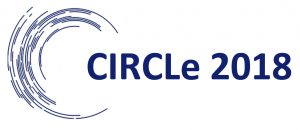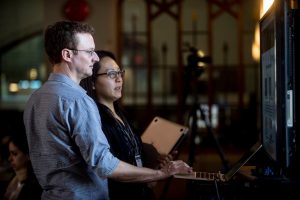Capturing and Reflecting the Learning Process through ePortfolios, 11:00 am to 12: 15 pm
- How can learning can be processed and represented using e-portfolios and online platforms?
- What do online platforms capture that other forms might not? What is problematic about using digital spaces for reflective practices?
- How can students use e-portfolios in more critical and reflexive ways?
- How should educators pedagogically distinguish between using e-portfolios as a tool for personal versus professional identity development?
- What are some best practices for documenting difficult, authentic, and complex learning experiences?
TABLE 1 DISCUSSION (Pedagogy & Reflection Group):
New questions raised in the group included:
- How do you balance student ePortfolio making to reflect on class + beyond amidst the stress and business in their lives?
- How do you grade or assess ePortfolios?
- Some things should be in a general outline but give room for movement
- Allow for students to workshop ePortfolios together and to receive feedback overtime. Build engagement within the student ePortfolio community.
- How to make ePortfolios work for archivists and librarians
- Mechanisms in ePortfolios to engage with practitioner presentations and readings
The following question was raised by an instructor teaching a professional development course in a Master’s program in Forestry:
- In a setting where students are very busy and overworked, how do we balance creating a portfolio that will be useful for them later with what they need to do to show what they’re learning in the Master’s program?
- Start by asking them to make an archive of their work and then select what they want to showcase that could speak to multiple audiences, perhaps
- Crucial role of audience: Students need to reflect on what audience(s) they are focusing on and selecting things specifically for that
- Allow them flexibility in what they want to show and how, what kind of format (formal portfolio, blog, something else)
- Consider removing assignment(s) from a course to make space for this in a course because it can be a great deal of work
- How do we grade them for this kind of work?
- Set out in a rubric what needs to be in there somewhere and let them choose how to show it exactly
- Consider some kind of peer workshopping/feedback and peer marking
Suggestion: Start small—ask students at first just to do small reflective assignments on a site. And then later, in another course or the same course, build up the site in small steps. Build room to grow over time and outside of that course. Allow for reflection as an integrative thing to all courses.
TABLE 2 DISCUSSION (Pedagogy & Instruction Group):
For Christine D’Onofrio’s use of eportfolios:
This discussion was moderated by Christine D’Onofrio, which allowed an opportunity to expand on some of the presentation content.
- Students really like the look of Wix.com (versus UBC platform) but when using a template, students were dependent on the design of the template. The templates became restrictive for students, or encouraged a superficial approach. Is this partly because they were Media Studies students?
- Maybe because they were visual design students, they were more aware of how they wanted their eportfolios to look like but were not deconstructing the limitations of the template or what the template was conveying for them by these pre-loaded options?
- Wanting students to really think about the purpose of their site. Academic art is about deconstructing meaning and process. What does a Wix template say?
- New tweaks for Christine’s course:
- Students need to use WordPress instead of Wix.com
- Encouraged students to develop research questions for all of their courses that would be reflected in the ePortfolio
- Evaluation is less about what it looks like but more focused on artifact critique
- Evaluating process and reasoning why decisions were made
For David Gaertner’s incorporation of eportfolios:
- Used Omeka
- Working with a community to reflect a community project
- Did a critical analysis on websites and then completed a reflection
Other comments:
- Students are frustrated they can’t make WordPress look the way they want, and it’s too difficult to support
- Q: Can paper templating help them be more thoughtful in the transition to a digital format?
- Takes time for students to learn skills necessary to create an eportfolio.
- Encourage them to settle on a first theme within the first couple of weeks, but let them know they don’t have to be married to it — at Royal Roads they may have more support
- Set time limits for students to spend on assignments as some students get obsessed with things like rollovers which takes time away for more valuable reflection and learning.
- “Ask 3 then me (including Google)” – Idea of asking three other peers (including Google) to find the answer before approaching instructor than instructional support
- Hoping that students learn and receive feedback from each other
TABLE 3 DISCUSSION (Professional Identity Group):
- Issue of mobility from an Indigenous perspective – Letitia suggested reading Wampum as Hypertext by Angela M Hass
- Discussion about the vulnerability of putting yourself out there; also the permanence of what is posted
Q: How do have students understand that what they might want to post now, may not be appropriate in a few years? How do we scaffold this?
- Tracy Penny Light asks students to write different versions of their story
- Different versions also shows students that their digital identity is constructed
Suggestion:
- Penny suggests that the university require that all students begin a portfolio and throughout their degree take a few more 1-credit courses to work on the portfolio as a frame to their degree/studies
In Geography the identity aspect is tricky, just given that we focus on really complex environmental issues
TABLE 4 DISCUSSION (Programs & Assessment Group):
- Curriculum mapping → identify those common points where all students pass through, and then focus more on those.
- Totally different considerations once you shift to program level rather than course level
Q: When is a good time to get started with the ePortfolios, is it sometimes too early or too late? Is there a problem getting in early in 1st year with 18 year olds? Are their brains ready yet?
- The Bachelor of Media Studies program have students make their own portfolios in the application process; audience is the faculty… would be interested in thinking where would they take it for the public eye? Take them to a new level in first year.
- Disciplinary considerations? In Christine’s class are looking forward to opportunity to make connections and display — portfolios are part of the disciplinary culture; other disciplines: why are you asking me to do this?
- Students find valuable having the history of their learning but not necessarily making it public, especially early product
- Framing as a formative place to document your intellectual progress from each year. Creating and sustaining relevance in time and adapting to its changes during the duration of the program.
- Valuable to keep all the history of learning for audits and self-reflection in later phases.
- In first year: maybe not the time to have the assignment be a “present yourself as a whole person” but as a reflective starting point with expectation that this will change over time & opportunity in the future to reflect on what they’ve grown and developed (e.g., have a course later include an assignment where there is a reflection backward)

